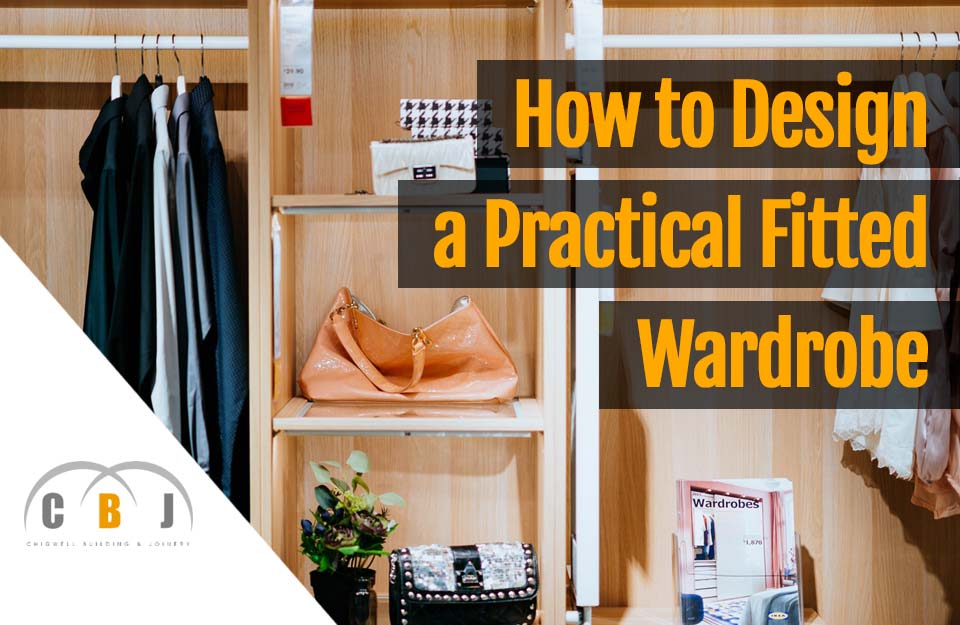
How to Design a Practical Fitted Wardrobe
Author Chigwell Building & Joinery
Date 09/07/19
Wardrobes have a tendency of being always piled up with clothes, and various other items.
For many people it is a problem to fit newly bought items in their wardrobe, and yet, new clothes and accessories need to be bought and stored somewhere!
So, if you are facing this kind of problem, why not try to make the best use of space by opting for a fitted wardrobe.
This will help to gain more storage space and be able to store more items.
Unfortunately it is common for people to have poorly designed wardrobes which do not make proper use of floor space and wall space.
If you would like to start afresh, we hope that the following guidelines on how to design a practical fitted wardrobe or closet will guide you to make good choices.
Read on to learn more, or use the jump links below to hop to a chapter that interests you:
Chapters
- Evaluate Your Needs
- Organisation is Key
- Ergonomic Design
- Drawers or No Drawers?
- Add Extra Storage
- Smart Shoe Storage
- Avoid Unnecessary Spending
- Be Flexible & Practical
- You Don't Have to Fit Everything!
Evaluate Your Needs
It is important to start by planning carefully.
Consider your needs, the number and types of items you need to store away in the wardrobe, and the space available in that room.
If you have a completely blank wall at your disposal, it might not be really necessary to use it all up.
First of all it will end up being unnecessarily costly, and you might even end up with unused space within the wardrobe.
That space could have been left for other furniture, decorations or simply floor space for more spaciousness.
So, you should try to ascertain the storage space that you really need.
This includes planning the hanging space you require, and the number and types of shelves.
Organisation is Key
You may be amazed at how much space you could end up saving, and making, if only you organised your clothes and any other items properly.
It is highly recommended that you take the time to group clothes according to size, so that you do not waste space when they are tucked away together in the wardrobe.
Also, consider the best height for the top rod.
The higher this rod is the more space you will then have to store underneath it.
Ergonomic Design
How often did you end up on the floor rummaging through items stored at the base of your wardrobe?
How much bending down did you end up doing?
Unfortunately this is a common problem with many who fail to take into account the importance of designing a wardrobe ergonomically.
An ergonomic design will not only prove to be more practical and convenient, but it will also enable you to find things more easily while keeping your wardrobe neat and tidy.
These are some smart tips you should bear in mind:
- It is best to place shelves right above hangers to gain more storage space.
- Shelves should be positioned about 10 inches apart.
- It is also recommended to have shelves which are not more than 14 inches deep as otherwise you will end up having items falling at their back.
- When a shelf has a width of 12 inches it is generally the best option as most folded clothes will fit nicely and tidily in that space.
Drawers or No Drawers?
Funnily enough while drawers may give the impression of helping you be more organised, in many cases they end up being a big no no with wardrobes.
First of all drawers take up a considerable amount of space which would have been more spacious if it had been left for a normal wardrobe door.
In fact if you were to think of it you would notice that drawers in reality restrict the wardrobe layout and waste space.
Only small items can be stored in drawers.
These include socks, underwear, and scarves.
All of these could be more easily stored in bedside tables or dressers.
Any folded clothes like sweater and t-shirts will also fit more easily and neatly on an open shelf rather than inside a drawer.
You would also be able to see them more easily.
Also, drawers end up increasing the costs involved to build a wardrobe.
So in reality they might as well be avoided.
Add Extra Storage
If you have a relatively small space you will need to use every storage possibility to the full.
In these cases it is recommended that you avoid folding clothes, but rather stick to hanging them.
A deep space in a wardrobe is best used for hanging clothes, rather than folded clothes which you cannot access easily because they end up falling towards the back.
A practical option is to include deep drawers underneath beds.
These can be used for shoes. Drawers should be left to other furniture such as a dresser, where they can accommodate small items like underwear and socks.
Smart Shoe Storage
For small rooms avoid storing shoes inside your wardrobe.
If however you want to cram them inside your wardrobe make sure to opt for a practical way to do so.
Shelves for shoes should be at mid-height so as to enable you to see them easily.
Shelves which slide out can be very convenient for shoes.
Also shelves used for shoes do not have to exceed 12 inches in depth.
Avoid Unnecessary Spending
While shopping for the material needed to build your practical fitted wardrobe you might be tempted to buy accessory storage devices.
Instead of spending a considerable amount of money on these supposedly innovative storage options you would do better with racks.
These can allow you to make good use of space and they are ideal for ties, belts and scarves.
Be Flexible & Practical
Try to make your wardrobe as adaptable as possible.
Different seasons call for different clothes and accessories.
So, why not do away with shelves for a while so as to use hanging rods.
As long as the holes for the rods can be used for the shelf supports, you can change from one to another easily.
Top shelves will come in handy to store off-season clothes and gear.
You Don't Have to Fit Everything!
While the wardrobe is the biggest furniture piece in your home, avoid being tempted to tuck away everything in it.
There are other rooms and other furniture at home.
So invest in simple shelving systems for other rooms in your home to store certain items there.


